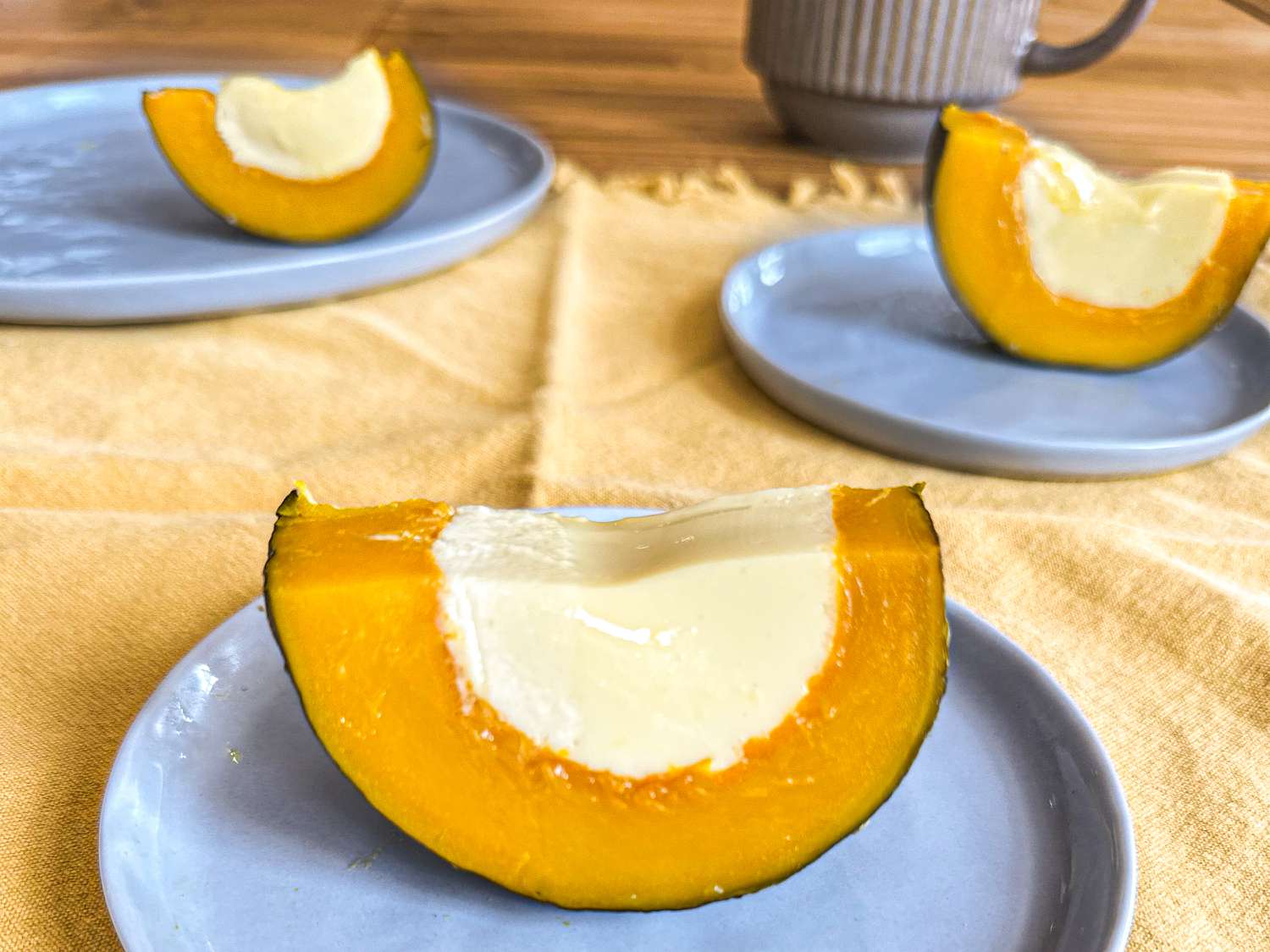
Why It Works
- Using a kabocha squash that weighs as close to two pounds as possible leaves little room for error in cooking time and ingredient ratios.
- Tempering the eggs and cooking the custard at a steady low temperature results in a silky smooth dessert.
- Baking the custard-filled pumpkin instead of the more traditional steaming method results in a more visually pleasing dessert with a more concentrated squash flavor.
The only time you’ll find me carving a pumpkin is to make sangkaya faktong, a traditional Thai dessert in which a hollowed-out kabocha squash is filled with a creamy pandan-scented coconut milk custard. While we call it a squash in North America, kabocha in Japanese means pumpkin, which is translated to faktong in Thai. In this recipe, the whole gourd is cooked until tender and sliced into wedges like a pie. It’s traditionally steamed, but I find that baking it at a steady low temperature is easier, tastes better, and results in a prettier pumpkin for showing off than when steamed—it’s the perfect dramatic centerpiece for your Thanksgiving table or any festive occasion.
While sangkaya faktong’s show-stopping presentation might give the impression that it is challenging to make, my version is actually relatively easy to assemble and cook (aside from its lengthy hands-off baking time). It’s a true “low effort, high reward” recipe that’s ideal for serving to guests. Here’s how to guarantee a silky set custard encased in a tender, perfectly baked pumpkin every time.
Serious Eats / Shri Repp
Selecting the Right Pumpkin for Sangkaya Faktong
Can You Substitute Kabocha for Another Squash?
People have asked me if they can make sangkaya faktong with a different winter squash than a kabocha. I’ve been around the pumpkin patch enough times in my life and really do think kabocha is best suited for this dish. It’s sweeter than other squashes (with a lovely chestnut note) but has a denser texture than, say, a sugar pumpkin, which might fall apart before the custard sets due to its thinner, less dense walls. Plus, you can’t go wrong with the striking contrast between kabocha’s deep green rind and bright orange flesh that’s showcased once sliced.
The Best Pumpkin Size for Sangkaya Faktong
Many sangkaya faktong recipes aren’t exactly foolproof—telling you to adjust ingredients and cooking time depending on the size of your pumpkin. Fortunately, grocery stores and farmers markets have scales, and I recommend you use one to find a small kabocha that’s about two pounds. If you follow my instructions below with a roughly two-pound kabocha, you’ll get a perfectly cooked and seasoned pumpkin and custard filling with little room for error.
Baking vs. Steaming Sangkaya Faktong
Traditional sangkaya faktong recipes, along with recipes for many other Thai desserts like kanom tuay and kanom chan, call for steaming the custard-filled pumpkin as the cooking method because ovens weren’t common in households back in the day. While older generations of Thai cooks are still less likely to cook with an oven (my mom uses hers for storage), I, a modern Thai-American cook, embrace my oven. I find that baking sangkaya faktong at a low steady temperature gets better results.
Serious Eats / Shri Repp
Steaming can cause the pumpkin flesh to get waterlogged and split—one of the main reasons people think this dish is a pain to make. Steaming on the stovetop also requires constant monitoring and more care to keep a steady heat level. While baking takes longer, it’s more hands-off and results in caramelized and buttery pumpkin flesh that’s wonderful when eaten with the slightly sweet and creamy custard. Baking the custard inside a pumpkin also insulates it behind the kabocha’s thick, moist walls, so there’s minimal risk of overcooking the custard. Whether steamed or baked, the custard is protected from drastic temperature changes inside the pumpkin.
Once the pumpkin is baked, you’ll be tempted to tuck into it right away, but it’s important to wait at least 30 minutes before slicing into this masterpiece so the custard has time to cool and set properly. This guarantees the perfect wedge of tender, creamy squash filled with rich custard. This dessert is equally delicious warm, at room temperature, and chilled—some people think it tastes best cold, so if you have any leftovers, just enjoy them straight out of the fridge.
Trending Products










